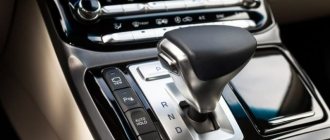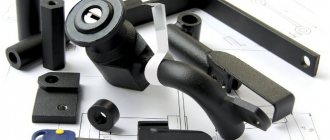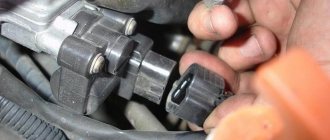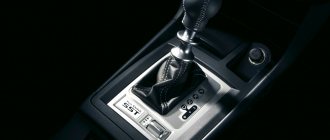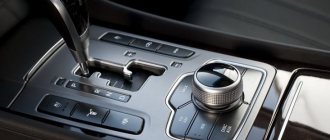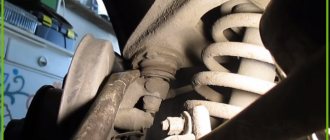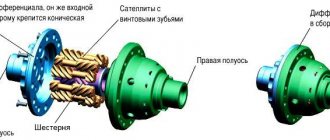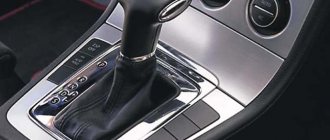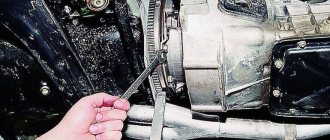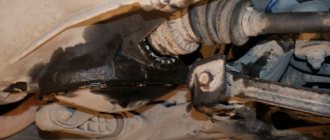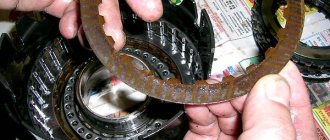In our article, we will look at the design and operating principle of an automatic transmission, list the main types of automatic transmissions, get acquainted with the operating modes, and analyze the advantages and disadvantages of automatic transmissions.
What is automatic transmission
An automatic transmission (AT) is a transmission that independently determines the most appropriate gear ratio depending on the current speed limit. The automatic transmission, without driver intervention, selects and switches the desired gear ratio, adapts to the speed set by the driver, and ensures a smooth start and smooth ride of the vehicle. The automatic transmission removes the lion's share of the load from the driver while driving compared to a classic manual transmission.
Since there are now different options for automatic transmissions (robots and CVTs), to avoid confusion, automatic transmissions are also called: classic automatic, hydraulic automatic, hydromechanical transmission, planetary automatic.
History of appearance
The first development that can be classified as an automatic transmission appeared in 1908 at the Ford plant in America. Model T was equipped with a planetary, still manual, gearbox. This device was not automatic, and required drivers to have a certain set of skills and actions to control, but it was much easier to use than manual transmissions without synchronization that were common at that time. The second important stage in the emergence of modern automatic transmissions was the transfer of clutch control from the driver to a servo drive in the 30s of the 20th century by General Motors. Such automatic transmissions were called semi-automatic. The first truly automatic planetary gearbox, Kotal, was installed in Europe in 1930. At this time, various companies in Europe were developing clutch and brake band systems.
Drawing of the Kotal checkpoint
The first automatic transmissions were very expensive and unreliable, until at the end of the 30s experiments began to introduce hydraulic elements into their design to replace servos and electromechanical controls. This development path was followed by Chrysler, which developed the first torque converter and fluid coupling. Modern automatic transmission designs were invented in the 40–50s of the 20th century by American designers. In the 80s of the 20th century, automatic transmissions began to be equipped with computer control; for fuel economy, 4- and 5-speed automatic transmissions appeared.
The history of the automatic transmission
The idea of creating an automatic transmission belongs to the German engineer Hermann Fettinger, who developed the first torque converter in 1902, and at first such a transmission was used only for the construction of ships.
The first car equipped with a planetary automatic transmission was the American Ford T. After the release of this car, the most active role in the development of automatic transmissions was played by General Motors, which managed to release a semi-automatic transmission in the mid-1930s. The same GM created the first completely automatic transmission in 1940
How to start it correctly
Drivers must not only know the principle of an automatic transmission, but also be able to operate it correctly. Unlike manual transmission, there are no difficulties here. The driver does not need to constantly monitor the speed limit and try to determine the moment to change speed by sound.
When you turn on the engine, the selector lever should be in “N” or “P”. The protection system signals the start in this way. If the lever is positioned differently, the ignition will not turn on. Before you start moving, you need to make sure of this. If the car is in the “P” value, then its drive wheels are blocked. This will prevent rolling. In the “N” position, emergency towing is possible. Automatic vehicles may start when the brake is applied. In this case, accidental rollback will not occur.
Automatic transmission device
An automatic transmission has a complex structure and the mechanism itself, through which gear shifting is ensured, is complex. The essence of this process comes down to turning the clutches and brakes on and off using the pressure of the working fluid.
There are several types of automatic transmissions that have some differences in design, but their basic elements are the same.
- Hydraulic transformer (torque converter)
. It is a metal body that is filled with a special working ATF fluid (oil). Its main task is to transmit rotation from the engine to the gearbox. In fact, this is an analogue of the clutch in a manual transmission. Consists of pump, turbine and reactor wheels, locking clutch and freewheel. The wheels have blades with holes for the circulation of working fluid. A freewheel is needed so that the reactor wheel can rotate in the opposite direction. The lock-up clutch allows you to lock the torque converter under certain vehicle operating conditions. - Planetary mechanism.
This is a gearbox that changes speeds as a result of changing the gear ratio on the gears. Consists of: planetary gears (sun gear, satellites, ring gear, carrier), shafts, drums with friction clutches, overrunning clutch and band brake. Blocking one of the elements of the planetary gear leads to the transmission of rotation and a change in torque. The planetary gear set can be locked by a band brake, an overrunning clutch and friction clutches. The planetary gear acts as a block of gears in a mechanical box. - Hydraulic system
. Consists of an oil pump, filter, pushers, hydraulic distributor. The working fluid creates working pressure in the box and protects internal elements from overheating and corrosion.
- Electronic control unit.
Collects incoming information from pedals, ABS and ESP systems, sensors, automatic transmission knob and other systems, processes it. Then it generates signals that are sent to the valve body actuator valves. The control unit regulates the operation of the friction clutches and directs the flow of working fluid to one or another clutch, which leads to a speed change. That is, the control unit is literally the “brain” of the automatic transmission; it controls the gearbox. A breakdown of the control unit leads to the machine switching to emergency mode.
How does automatic transmission work?
In order to understand the principle of operation of an automatic transmission, we will roughly divide it into three parts: hydraulic, electronic and mechanical. As you might guess, the mechanical part is directly responsible for shifting gears. Hydraulic transmits torque and creates an impact on mechanical. Electronic is the brain that is responsible for switching modes (selector) and feedback from car systems.
As you know, the heart of a car is the engine, and in the case of a gearbox, this is also appropriate. The transmission must convert the power and torque of the engine in such a way as to provide the necessary conditions for vehicle movement. The torque converter (aka the donut) and planetary gears do most of this heavy lifting.
The torque converter , depending on the wheel speed and load, changes the torque automatically and performs clutch functions (as in a manual transmission). In turn, the torque converter consists of a pair of bladed machines - a centripetal turbine and a centrifugal pump, and a guide apparatus-reactor is located between them.
The turbine and pump are as close as possible, and their wheels are shaped to ensure a continuous circulation of working fluids. It is thanks to this that the torque converter has minimal overall dimensions and minimal energy losses when fluid flows from the pump to the turbine. The engine crankshaft is connected to the pump wheel, and the gearbox shaft is connected to the turbine. In view of this, in the torque converter there is no rigid connection between the driven and driving elements; flows of working fluids transfer energy from the engine to the transmission, which is thrown from the pump blades to the turbine blades.
How automatic transmission works video:
Fluid coupling and torque converter
- Which automatic transmission is the most reliable?
Strictly speaking, a fluid coupling works according to the same scheme, without transforming its value, it transmits torque. The reactor is introduced into the design of the torque converter in order to change the torque. In principle, this is the same wheel with blades, only it is rigidly mounted on the body and does not rotate until a certain time. On the path along which oil returns from the turbine to the pump there is a reactor. The reactor blades have a special profile; the interblade channels gradually narrow. Due to this, the speed of the working fluids flowing through the channels of the guide vane gradually increases, and the fluid ejected in the direction of rotation of the pump wheel from the reactor accelerates and pushes it.
Comparison of automatic transmission with manual transmission
In the modern world, “mechanics” are slowly but surely losing ground to their more progressive counterpart - automatic transmission. Automatic transmissions provide smoother and more economical engine operation and smoother running of the machine.
The driver is not required to constantly monitor the speed and engine speed in order to engage the desired gear in time. The automatic will do everything for him, which is especially convenient when driving around the city, and extremely convenient if you are in a traffic jam.
The driver does not need to devote the lion's share of his attention to driving the car. Although there are drivers who like a manual transmission, which allows them to enjoy the continuous physical process of driving the car and complete control of the ride.
Pros and cons of automatic transmission
An automatic transmission has its advantages and disadvantages, which you need to know before buying a car with an automatic transmission or switching from a manual transmission to an automatic transmission.
Pros of automatic transmission
- Simplicity and ease of control, as there is no need to manually switch speeds. The driver only controls the steering wheel and presses the gas and brake.
- The third pedal, the clutch, is missing.
- It's easier to get moving in a car with an automatic transmission.
- Smooth gear shifting and high efficiency.
- High reliability of modern automatic transmissions.
- Inability to “burn out” the clutch and no need to periodically replace the clutch.
Disadvantages of automatic transmission
- Manual transmissions are more economical than automatic transmissions. A car with an automatic transmission consumes about 10-15% more fuel. Although the gradual improvement of machines leads to a decrease in this indicator.
- Automatic transmissions are much more expensive than manual transmissions to maintain and repair. If the machine breaks down and needs to be completely replaced, it will cost a significant amount (up to a third of the cost of a used car).
- The impossibility of rapid acceleration and a sharp increase in speed, which is especially felt when overtaking at a limited distance or in dense oncoming traffic, that is, when you need to overtake very quickly. This problem is partially solved by turning on the sports mode.
- The automatic limits the individual driving experience, unlike manual cars where the driver has complete control over the ride.
- Inability to push start the car.
- The machine can quickly fail if used incorrectly.
- An automatic car has towing limitations, and these are things you need to know before towing another car or trailer.
Types of automatic transmission | Comparison with mechanics | Advantages and disadvantages
The constant improvement in the quality of operation of a modern vehicle has inevitably led to noticeable structural complexity. Equipping the car with an automatic transmission had a favorable effect on the engine, speed characteristics and chassis, which also made it possible to partially lighten the driver’s load while driving. Due to its ease of operation and reliability, the use of this invention has found wide application.
Nowadays, automatic transmissions are widely used in both passenger cars, all-wheel drive cars, and trucks. In order to move at the required speed, the driver of a car with a manual gearbox needs to “pull” the gearshift lever quite often, and he must independently monitor the speed and load. Using an automatic transmission eliminates these needs.
There are obvious advantages of an automatic machine over a manual one, such as:
- Driving comfort increases;
- Automatic gear shifts occur smoothly;
- The chassis and engine protect against overloads;
- Both automatic and manual gear shifting are possible.
Automatic transmissions used today are conventionally divided into two types. These types differ mainly in the systems for monitoring and controlling the use of the transmission.
- In the first type of automatic transmission, control and monitoring is performed by a specific hydraulic device.
- The same function in an automatic transmission of the second type is performed by an electronic device. Robotic boxes.
Here are some very specific examples:
Suppose a car is moving along a flat section of the road, a section with a steep slope. For some time we do not touch the accelerator pedal and observe the reaction of the torque converter as driving conditions change. As the load on the drive wheels increases, the car loses speed. As a result, the turbine rotation speed drops. This affects the resistance to the movement of working fluids inside the torque converter. As the circulation speed increases, it automatically increases the torque on the turbine wheel shaft until an equilibrium arises between it and the moment of resistance to movement.
This is exactly how the automatic machine works when moving away. Only now is the time to use the accelerator - after this, the crankshaft speed increases and so does the pump wheel, and the car and turbine were stationary, but slipping inside the torque converter did not prevent the engine from idling. In this case, the torque is transformed as many times as possible. But once the required speed is achieved, torque conversion becomes unnecessary. With the help of an automatically operating lock, the torque converter turns into a link that rigidly connects the driven and drive shafts. With such blocking, internal losses are eliminated, the transmission efficiency value increases, in this driving mode, fuel consumption decreases and the efficiency of engine braking during deceleration increases.
The reactor is released and rotated with turbine and pump wheels to reduce all the same losses.
For what purpose is a gearbox attached to a torque converter when it can independently change the amount of torque depending on the load on the drive wheels?
The torque converter is capable of changing torque with a coefficient of 2-3.5 no more. And for efficient operation of the transmission, such ranges of changes in subordinate numbers are clearly not enough. Also, sometimes it becomes necessary to engage reverse gear or neutral. Automatic transmissions, having gears, still differ in many ways from manual transmissions; for example, they change gears without interrupting the power flow using multi-disc friction clutches driven by hydraulics and band brakes. Depending on the speed of the car and the intensity of pressing the accelerator pedal, the desired gear is automatically selected, and it determines the intensity of acceleration.
The electronic and hydraulic control units of the automatic transmission determine the desired gear. The driver, in addition to pressing the gas pedal, can select sport or winter modes (such automatic transmission modes have an individual gear shift algorithm), and can also select a mode that helps to move along sections of the road with difficult terrain (in this mode, the automatic transmission will not be able to shift above a certain gear) .
In addition to the planetary gear and torque converter, the automatic transmission also includes a pump that supplies the hydraulic unit with the torque converter with working fluid and lubricates the box, and the automatic transmission cooling radiator, which is part of the automatic transmission, cools the working fluid, which tends to overheat.
Differences in the automatic transmission design of rear-wheel drive and front-wheel drive cars
There are also several differences in the design and layout of automatic transmissions between rear-wheel drive and front-wheel drive vehicles. In front-wheel drive cars, the automatic transmission is more compact and inside the housing it has a main gear compartment, i.e., a differential. Otherwise, the functions and operating principles of all automatic transmissions are the same. To ensure movement and perform all functions, the automatic transmission is equipped with such components as: a torque converter, a control and monitoring unit, a gearbox and a driving mode selection mechanism.
Rear wheel drive car Front wheel drive car
Types of automatic transmission
There are now three types of automatic gearboxes:
- classic automatic transmission
. When they say automatic transmission, they mean this particular type of gearbox, and in this article we are talking about this type. They are installed on most modern cars and trucks, although the other two types are gradually increasing their presence in the car market. - Robot
(robotic gearbox). It is one of the automatic transmission options. Its main feature is the presence of a clutch, which ensures quick gear changes without loss of engine power. The robot has input and output shafts, which are combined using gears, which leads to speed switching; they are controlled by a synchronizer. The robotic gearbox is usually controlled by a special electronic control unit, but can also be controlled by the driver. - The variator
does not have fixed gears, so speed shifting is very smooth. The speed mode is switched using cone-shaped pulleys at the input and output of the box. The belt connection ensures the movement of the nodes. The planetary gear is responsible for reversing. The CVT has the highest efficiency of all automatic transmissions.
Operating principle and service life of automatic transmission
When the engine starts, transmission oil enters the torque converter, the pressure inside increases, and the blades of the centrifugal pump begin to rotate.
This mode provides for complete immobility of the reactor wheel along with the main turbine.
When the driver shifts the lever and presses the pedal, the speed of the pump blades increases. The speed of the vortex oil flows increases and the turbine blades are launched. The liquid is alternately transferred to the reactor and returned back to the turbine, increasing its efficiency. Torque is transmitted to the wheels, and the vehicle begins to move.
As soon as the required speed is reached, the bladed central turbine and the pump wheel begin to move at the same time. The oil vortices enter the reactor wheel from the other side, since movement can only be in one direction. It starts to spin. If the car goes up, the wheel stops and transmits more torque to the centrifugal pump. Achieving the required speed leads to a gear change in the planetary gear.
At the command of the electronic control unit, the braking band with clutches slows down the lower gear, which leads to an increase in the movement of oil flows through the valve. Then the higher gear is accelerated, its change is made without loss of power.
If the machine stops or its speed decreases, the pressure of the working fluid also decreases and the gear shifts down. After turning off the engine, the pressure in the torque converter disappears, which makes it impossible to start the car from the pushrod.
The weight of the automatic transmission reaches 70 kg when dry (there is no hydraulic transformer) and 110 kg when filled. In order for the machine to function normally, it is necessary to control the level of the working fluid and the correct pressure - from 2.5 to 4.5 bar.
The resource of the box may vary. In some cars it lasts about 100,000 km, in others - more than 500,000 km. The service period depends on how the driver monitors the condition of the unit and whether he replaces consumables on time.
Operating principle of automatic transmission
When the engine starts, the automatic transmission is activated by turning on the oil pump, which creates operating pressure inside the transmission. After this, the hydraulic transformer is started, which spins up to the speed of the crankshaft.
When you press the gas pedal and switch the automatic control knob, oil rushes to the turbine, which begins to rotate. The operation of the automatic transmission radiator prevents overheating of the transmission oil. The control unit collects all incoming information from the degree of pressure on the gas pedal and various vehicle sensors, processes it and sends a signal to the hydraulic unit, where, by moving the clutches and brakes, the gear ratio is changed, the most optimal in the given specific conditions.
The oil that fills the internal cavity of the automatic transmission is essential for its efficient operation. You need to monitor the oil level so that it is not too much or too little. The operating oil pressure is 2.5-4.5 bar.
The operating temperature of the oil is 80ºC, so before starting to drive the car should be warmed up a little, which is especially important in winter to avoid damage to the plastic elements of the box.
Oil cooling most often occurs due to a liquid radiator, less often - an air radiator. An unfilled automatic transmission and without a torque converter weighs on average about 70-80 kg. After refueling, its total weight can reach 110 kg.
What does an automatic transmission consist of?
1. Torque converter - similar to the clutch in a manual transmission, but does not require direct control by the driver. 2. Planetary gear set is similar to a gear block in a manual transmission and changes the gear ratio in an automatic transmission when changing gears. 3. Brake band, rear clutch, front clutch - they are used for direct gear shifting. 4. The control device is a whole unit consisting of a gear pump, valve box and oil sump. The valve plate (valve block) is a system of channels with valves (solenoids) and plungers that perform monitoring and control functions; it also converts the engine load, the degree of pressure on the accelerator and the speed of movement into hydraulic signals. Based on such signals, due to the sequential activation and exit from the operating state of the friction blocks, the gear ratios are automatically changed.
Torque converter Planetary gearset
Brake band Clutch packs
Torque converter - designed to transmit torque from the engine to the automatic transmission components. It is installed in a casing located between the gearbox and the engine, performing clutch functions. Filled with working fluid during operation, it carries high loads while rotating at a fairly high speed. It, absorbing and smoothing engine vibrations and transmitting torque, drives the oil pump, which is located in the gearbox.
The oil pump, in turn, fills the torque converter with transmission fluid, thereby creating the required pressure in the monitoring and control system. Therefore, the opinion that a car with an automatic transmission can be forced to start without a starter by accelerating it to high speed is erroneous. The gear pump receives energy only from the engine; when the engine is not running, there is no pressure in the monitoring and control system, regardless of the position of the gear shift lever handle. Therefore, the rotation of the driveshaft will not force the box to work or the engine to start.
Planetary gearset - unlike “mechanics”, where gears and parallel shafts mesh with each other, “automatic gearboxes” mainly use planetary gears.
Components of the clutch - oil pressure sets the piston in motion. The piston, moving under oil pressure, uses a conical disk (dished plate) to press the driven disks of the package very tightly against the drive disks, from which they rotate as a single unit and transmit torque from the drum to the bushing. Several planetary gears providing the necessary gear ratios are located in the gearbox housing.
The transmission of torque from the engine through planetary mechanisms directly to the wheels is carried out using friction discs, differentials and other service devices. All of the listed devices are controlled through the transmission fluid through the monitoring and control system.
Brake band is a device by which the elements of the planetary gear are blocked.
The valve body is the most complex mechanism in an automatic transmission. As we wrote above, these are the brains of the transmission. The most expensive part to repair.
Automatic transmission device Video
Automatic transmission resource
There is no exact value for the service life of an automatic transmission. This will depend on the correct operation of the car with automatic transmission, timely maintenance of the gearbox: changing the oil and oil filter, using original spare parts and oil. Some models of automatic transmissions are designed for 100-150 thousand mileage, modern car models are equipped with automatic transmissions designed for 500 thousand km or more, and do not require an oil change.
You can read more about changing the oil in automatic transmissions in our article: Changing the oil in automatic transmissions
Conclusion
What conclusion can be drawn? Engineers have created an automatic transmission that is complex enough to simplify its operation as much as possible. As a result, the convenience and functionality of a modern automatic transmission outweighs any doubts about its reliability. It is for these qualities that drivers appreciate the opportunity to use an automatic transmission and not create unnecessary problems for themselves in life. Yes, an automatic transmission can fail, like any other component of a car, but with proper use it can last a very long time.
Automatic transmission operating modes
If you have never driven a car with an automatic transmission, you must first find out what operating modes the box has, how they are indicated on the panel and how to use them. Improper operation can lead to box failure and costly repairs.
All control of the gearbox is carried out through the handle; its certain position turns on a certain operating mode. On different automatic transmission models, the number of modes may be different.
Basic operating modes of automatic transmission
- P - Parking . It is analogous to a handbrake on a manual transmission. This mode is activated when the car is parked. In this position of the handle, the front drive wheels are blocked not by pressing the brake pads, but by blocking the transmission output shaft.
- N - Neutral (neutral position) . The wheels and shaft are not locked, but are not connected to the engine either. In this position, the car can coast. If you leave the car in the parking lot in this position, the car may roll downhill, so you should not park the car in this mode. This position is used when towing a vehicle.
- R - Reverse (reverse speed). Enables reversing. In order to move in reverse, you need to press the brake pedal, move the selector to the “R” position, release the brake, press the gas.
- D or A—Drive or Automat (main driving mode) . Used while driving in automatic gear shift mode.
- L or B or number 1 - Low (low gear mode) . An analogue of first gear on a manual transmission, which involves driving at a reduced speed. On some models, mode B enables differential locking.
- M - Manual (manual gear shift mode). It is used when the driver needs to engage the desired gear himself. It works in a similar way to a manual transmission, only in a more simplified version. The gearbox is controlled in this mode using special “+” and “–” buttons (steering wheel paddles).
- S or PWR - Sport or Power (sports mode). In this mode, gear changes occur at high engine speeds without loss of speed. Implies the ability to quickly accelerate and gain speed, for example when overtaking. Also used for active driving at maximum engine speeds.
- O/D - OverDrive. Overdrive is an overdrive; this mode is analogous to fifth gear in a manual transmission. The overdrive mode is used when driving outside the city at a steady speed above 50 km/h, or when driving at high speed. It saves fuel consumption.
- D3 or O/D OFF - disables overdrive.
- W or S or number 2 - Winter or Snow (winter riding) . This means starting from a stop and driving no higher than second speed. Used in winter under poor road conditions.
- «3» – driving mode is not higher than third gear.
- E - Economic (economical mode).
- Shift lock - button to unlock the gearbox selector when the engine is off. The automatic transmission is automatically locked when the engine is turned off. That is, in order to move the selector to the Drive position from the Parking position, you must first start the engine; this cannot be done with the engine turned off. But if you press the Shift lock button, you can move the selector to any position. During normal operation of the automatic transmission, it is better not to use this button; it is intended for mechanics who repair automatic transmissions.
- Kick-down - “kick down”. Something like a low gear for the “mechanics”. Pressing this button allows you to quickly gain high speed by shifting to a lower gear. The button is located under the gas pedal. When you sharply press the gas all the way, kickdown is activated.
Comparison of manual and automatic transmission
If the future driver does not know which car with which gearbox to buy, he needs to study the principle of operation of an automatic transmission and a manual one. In addition, it is worth deciding for what purpose the car is being purchased, and whether the person has any driving experience at all.
Cars with automatic transmission cost at least 50,000 rubles more than manual transmissions. This is due to the fact that you always have to pay for comfort. Each gearbox requires maintenance and oil changes. An automatic transmission will require 6-10 liters of fluid, while a manual transmission will require only 3 liters. Accordingly, automatic transmission maintenance will be more expensive.
As for acceleration and efficiency, the mechanical ones have higher parameters. With manual control you can accelerate to full speed almost immediately, which cannot be said about the automatic. If we take into account the reliability parameter, then it becomes difficult to compare both boxes. The mechanical design looks more reliable, since it lacks electronics. But the machine, in turn, completely controls the operation of the system, excluding the “human factor”.
Operating a car in winter will become more comfortable with the mechanics. The fact is that the car is ready to drive almost immediately after starting. Also, the mechanics are not afraid of ice and slipping. A large volume of fluid does not allow the automatic transmission to warm up faster than a manual transmission. When towing on ice, the engine will begin to overload, increasing wear on parts.
In terms of driving comfort, the automatic transmission wins. A beginner will be able to calmly move away, drive up a mountain and not stall on the road. Driving a manual requires care and control.
Automatic and manual interact with the engine differently. A manual transmission can spin the engine to the limit, thereby reducing its service life. The automatic machine does not allow you to do this because it controls the engine speed.
Starting the engine with automatic transmission
In cars with automatic transmission there are only two pedals for the driver’s right foot: gas and brake, there is no clutch. When starting the engine, the gas is not pressed, but in most cars you need to press the brake pedal, otherwise the car will not start.
Cars with automatic transmission have a built-in blocking of movement when the selector handle is in the wrong position. A car with an automatic transmission can only be started if the gearbox lever is in the “P” - park or “N” - neutral position. In all other positions of the lever, the car will not start.
This feature is especially useful for novice drivers who may forget to move the lever to the desired position and the car will jerk forward or backward when the ignition is turned on and crash into something.
Most automakers recommend always leaving the car parked in “P” mode and driving away only from this position.
Experienced drivers are advised to always press the brake when starting the engine: this will prevent the car from moving in neutral gear in the “N” position. Also, without pressing the brake, it will not be possible to move the selector to position “D” - start moving and “R” - reverse.
There are slight differences in how to start a petrol and diesel automatic car.
Starting a gasoline engine
- Insert the key into the ignition.
- The selector should be in the “Parking” position.
- Press the brake pedal.
- Turn the ignition key without releasing the brake pedal.
- Allow the engine and gearbox to warm up for some time (especially in winter) so that the oil becomes more fluid. Warming up takes about 5 minutes, or you need to wait until the oil warms up to 70ºC, if such information is displayed on the monitor.
- The selector handle must be moved through all positions so that the oil is distributed evenly throughout all components of the box.
- Release the brake pedal and move the selector to the Drive position, the car will start moving.
Starting the diesel engine
Cars with a diesel engine are equipped with glow plugs, and they must be warmed up before driving.
- Insert the key into the ignition.
- The selector should be in the “Parking” position.
- Wait a while until the glow plug indicator goes off on the monitor. If it is below 20ºC outside, it is recommended to repeat warming up the candles 1-2 more times.
- Press the brake pedal.
- Turn the ignition key without releasing the brake pedal.
- Now, just like with a gasoline engine, you need to let the engine warm up and move the selector knob through all positions to distribute the oil.
- Release the brake pedal, move the selector to the Drive position, and the car will start moving.
After turning the key in the ignition before starting the starter, it is better to wait a few seconds for the fuel pump to start.
A car with an automatic transmission: advantages and disadvantages
Let's start with the positives. Installing an automatic transmission allows the driver not to use the gear lever while driving, and the foot is also not used to constantly depress the clutch when changing to a higher or lower gear.
In other words, the speed change occurs automatically, that is, the box itself takes into account the load on the internal combustion engine, the speed of the vehicle, the position of the gas pedal, the driver’s desire to accelerate sharply or move smoothly, etc.
As a result, the comfort of driving a car with automatic transmission increases significantly, gears are switched automatically, softly and smoothly, the engine, transmission elements and chassis are protected from heavy loads. Moreover, many automatic transmissions provide the possibility of not only automatic, but also manual gear shifting.
As for the disadvantages, they also exist. First of all, structurally, an automatic transmission is a complex and expensive unit, characterized by reduced maintainability and service life compared to mechanical (manual) transmissions. A car with this type of gearbox consumes more fuel; an automatic transmission delivers less torque to the wheels, since the efficiency of the automatic transmission is slightly reduced.
Also, the presence of an automatic transmission in a car imposes certain restrictions on the driver. For example, an automatic transmission needs to be warmed up before driving; it is advisable to avoid constant sudden starts and too intense braking.
A car with an automatic transmission must not slip; it is not allowed to tow a car with an automatic transmission at high speed over long distances without hanging the drive wheels, etc. Let us also add that such a box is more difficult and expensive to maintain.
Driving a car with automatic transmission and stopping
After you have started the engine, moved the gearbox to position “D”, released the brake pedal, the car begins to move at a low speed of about 5 km/h. We press the gas pedal and the car accelerates. The harder you press the gas pedal, the faster the car will go.
To reduce the speed of the car, you need to take your foot off the gas pedal, the automatic transmission will engage in a lower gear and the speed will decrease. To quickly reduce speed, press the brake pedal.
To stop the car you need to take off the gas and press the brake. The car will stop. If you plan to leave the car in the parking lot, then with the brake pedal pressed, move the selector knob to the “P” (parking) position and turn off the engine.
If you stop at a traffic light or are stuck in a traffic jam, then you do not need to move the handle to the “parking” position. It remains in position "D". To start moving, release the brake and press the gas.
Sometimes the “M” mode (manual mode) is convenient for driving. It turns on while driving in position “D”. Speed shifting occurs using the “+” and “-” buttons located on the gear shift lever. This mode is used when driving on a bad dirt road in a low gear in order to avoid slipping. And also during steep ascents and steep descents.
Panel symbols
An automatic transmission whose operating principle is very simple, has a panel with alphabetic symbols and numbers. To control the automatic transmission, it is worth understanding them. Designations may vary depending on the make of the machine.
R - parking. Turns on when the car is parked. This is a kind of parking brake in which there is a shaft lock.
R - reverse speed. It turns on when the car starts moving backwards.
N - popularly called “neutral”. If the car is at neutral speed, then its wheels are not locked. If something happens, the car may “roll”.
D - stands for forward movement.
A - automatic mode.
M - imitation of a manual transmission in a simplified mode.
L and B - low gear.
S - sport mode.
W - “winter” mode, allowing you to start from 2nd gear.
OD - accelerated mode.
E - economical mode.
Before you learn how an automatic transmission works, as well as what certain symbols on the panel mean, you need to read the instruction manual. For different car models, the meaning of the letters may differ. For example, sometimes B means lock, and L is translated as “Lock,” which means “lock.”
What not to do with automatic transmission
To ensure that the automatic transmission lasts a long time and does not break, you cannot do certain things.
- Start a car with an automatic transmission using a pushrod. Such a start will halve the life of the automatic transmission.
- You cannot drive in the “P” (parking) position.
- Use the “N” (neutral) position to descend the hill. Especially if you turn on this mode right on the move from position “D”. In this case, the car may stall, the power steering and brakes are turned off, and the car becomes practically uncontrollable.
- Use the “N” position during normal driving.
- Engage the “R” (reverse) position until the machine comes to a complete stop.
- Engage the “D” (drive) position while reversing until the vehicle comes to a complete stop.
- Tow a vehicle that weighs more than yours.
- Tow a car with automatic transmission for a distance of more than 40-50 km at a speed of more than 50 km/h. In a towed car with the engine turned off, the automatic transmission does not create the required oil pressure, so all the parts in it rotate without the required amount of lubrication, which leads to rapid wear.
At first glance, an automatic transmission appears to be some very complex mechanism, which is very difficult to control and maintain in working condition. Actually this is not true. For those drivers who have driven a manual for a long time, the period of getting used to an automatic may be a little difficult. But those who have always driven only an automatic transmission believe that a car with an automatic transmission is much easier to drive.
Maintenance and repair
Having figured out how an automatic transmission works, you need to study the maintenance features of the machine itself. No matter how reliable and new the car may seem, you should not neglect maintenance. This will help get rid of most problems.
Checking the oil in a timely manner, as well as replacing the oil filter, is what you need to do first when visiting a service station.
The oil and filter require replacement every 50-60 thousand kilometers. Vehicles operated in difficult conditions must be “checked” every 30-40 thousand km. Do not allow the oil level to be low. The coordinated work of the CP depends on him. An insufficient amount of oil leads to slipping, which consequently provokes overheating.
When the oil level is low, a characteristic hum appears coming from the torque converter. An excessive oil level is also unacceptable. Overfilling makes the lubricant poor quality. Thus, the entire mechanism fails completely. You can check the level using a dipstick.
When pouring liquid, you need to be extremely careful. After the procedure, you should drive no more than 10 km and then check the level again. When checking, the machine must be placed on a level surface. Having measured the level, the driver will have to either drain the excess or add fluid. It is not recommended to mix oils from different manufacturers. This is guaranteed to lead to automatic transmission failure.
Do not forget that when draining the oil, the driver must change the filter. It is advisable to remove the pan and gasket along with it. The maintenance will determine if anything else needs to be changed. If the box was operated in accordance with the recommendations, then no additional “intervention” will be required.
It happens that the oil begins to darken and smell like burning. The clutches may have worn out. In this situation, additional maintenance of the box with disassembly is required.
Additional automatic transmission maintenance includes flushing and diagnostics. Washing is carried out rarely, only after the box is heavily soiled. Flushing is especially necessary when the mechanisms are completely destroyed, or at a time when the unit is already very old and functions poorly.
Among other things, automatic transmissions often experience leaks, electric motor malfunctions, and lack of sealing.
Diagnostics, in turn, is carried out using self-diagnosis or a computer. Regular procedures allow you to identify problems at an early stage. If you miss this moment, there will be a need for expensive repairs. Proper maintenance will increase the life of the gearbox.
Device
Hydromechanical gearbox - “automatic” consists of a torque converter and an automatic planetary gearbox.
The design of the torque converter includes three impellers:
- pumping (rigidly interacts with the housing);
- turbine;
- stator. Located in the gap between the two previous wheels. It integrates a clutch that slows down the rotation of the stator as the speed increases through a pump wheel. When the speed reaches three quarters of the limit, the stator clutch completely blocks (“stop mode”). Some design modifications provide for forced braking using a friction clutch - this increases the efficiency of the torque converter at different speeds.
Each element of a gas turbine engine (torque converter) requires a strict approach during production, synchronous integration, and balancing. Based on this, the gas turbine engine is manufactured as a non-dismountable unit that cannot be repaired.
The structural location of the torque converter is between the transmission housing and the power plant - which is similar to the installation niche for the clutch on a manual transmission.
